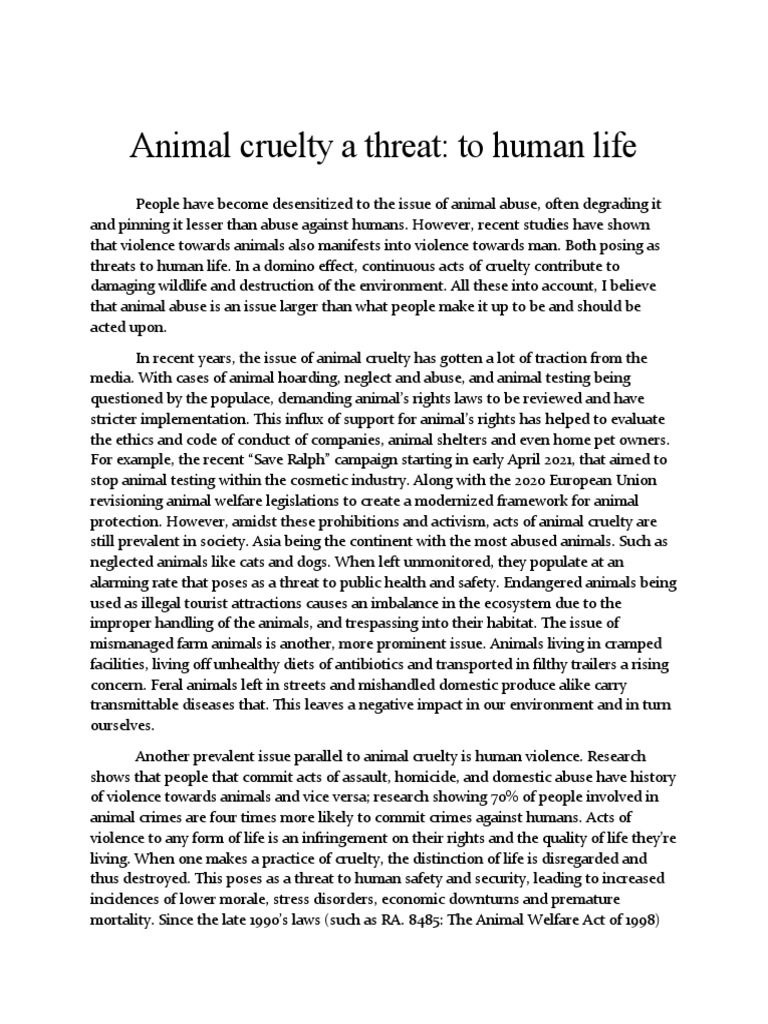When considering the complex and emotionally charged topic of animal cruelty, have you ever wondered how one could effectively articulate their thoughts in a structured essay? The challenge lies not only in presenting factual information but also in capturing the reader’s empathy and motivating them to action. Crafting an essay on animal cruelty requires meticulous planning and organization. In this discourse, we will explore essential components and strategies essential for structuring a solid and compelling essay.
A well-constructed essay typically begins with a cogent introduction. This is the crucial stage where the writer must hook the reader’s attention and establish the topic’s significance. To engage the audience, consider posing a provocative question: “What does the suffering of millions of sentient beings teach us about our ethical responsibilities?” Following this enigmatic question, provide context to illustrate the enormity of the issue. Briefly define animal cruelty, outlining its various forms and the societal implications that ensue. This introduction should culminate in a clear and persuasive thesis statement that encapsulates the main arguments to be explored throughout the essay.
Proceeding into the body of the essay, create a coherent structure that frequently transitions between individual points. Typically, an essay on animal cruelty may consist of three or four main sections, each dedicated to a specific facet of the issue. Begin with a historical analysis, presenting how the perception of animal welfare has evolved over time. Discuss landmark legislation, such as the Animal Welfare Act, and critical case studies that have delineated the boundaries of acceptable treatment of animals.
The second section might concentrate on the psychological and sociological factors contributing to animal cruelty. Research indicates that individuals who perpetrate acts of cruelty often demonstrate underlying psychological issues, which begs the question: how can society intervene to mitigate these attitudes? Explore existing psychological theories and delve into the socialization processes that normalize violence against animals. This discussion should be accompanied by statistical data to underline the correlation between animal cruelty and broader societal violence.
In the subsequent section, the focus should shift to the horrific consequences of animal cruelty on both animals and humans. Detail the physical and psychological impact of abuse, using case studies that evoke empathy. This section should also address ecological ramifications, such as the effects of factory farming and habitat destruction on biodiversity. Real-world examples, such as puppy mills or the treatment of circus animals, can serve as poignant illustrations of the far-reaching effects of cruelty.
A crucial aspect of the essay is advocating for change. Thus, a section that outlines methods for reducing animal cruelty and promoting vegetarianism or veganism could be highly effective. Discuss the role of education, highlighting the importance of teaching empathy towards animals in schools and communities. Encourage the reader to contemplate their dietary choices and how supporting ethical alternatives can contribute to reducing demand for products associated with cruelty.
To strengthen your arguments, integrate compelling counterarguments. Address common misconceptions surrounding animal rights, such as the belief that animal cruelty laws impede legitimate agricultural practices. By countering these claims thoughtfully and respectfully, you further reinforce your thesis and showcase a balanced analysis of the topic.
Transitioning towards the conclusion, summarize the main arguments while reiterating the importance of recognizing animal cruelty as a pressing societal issue. Inspire readers by encouraging them to participate in activism, whether through volunteering for animal shelters or supporting legislation aimed at improving animal welfare. Lastly, leave readers with a profound statement or a call to action that resonates long after they have finished reading. A question might be appropriate here as well: “What if your next meal considered the life of another being?”
In constructing a solid essay on animal cruelty, remember that clarity is paramount. Employing a formal tone with technical terminology can lend authority to your piece, yet balance it with accessible language to ensure the message resonates with a diverse audience. Ensure that transitions between sections are fluid to keep the reader engaged. The presentation of a well-researched, carefully structured essay has the power to enlighten minds and galvanize change, forging a path toward a more compassionate society for all living beings.








